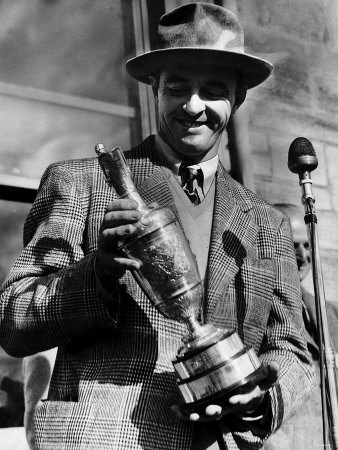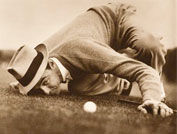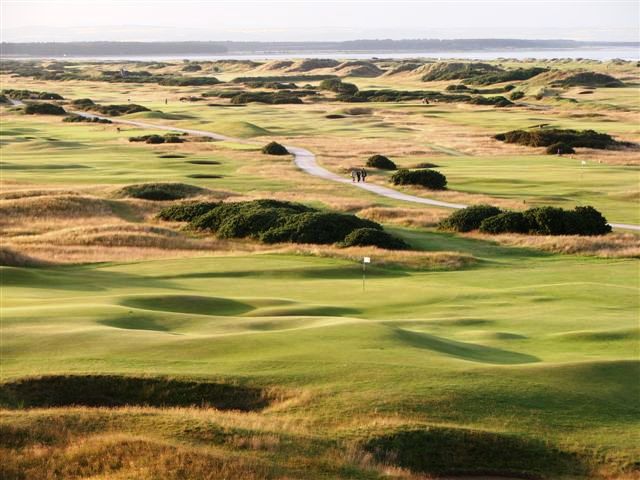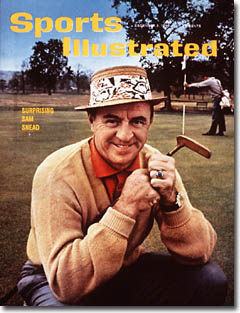[May 27, 2012]–Sam Snead poked me in the stomach. More than once. I’ve told this tale before, but with Snead’s 100th birthday today, it’s worth dusting off a few chestnuts in memory of one of the best of all time.
The reason Snead was jabbing me in the gut, other than that it was an obvious target, was that he was trying to make a point about how it had cost him close to $2,000 to travel and play in the 1946 British Open at St. Andrews. He won the tournament, but the winner’s check came to only $600.
Though he probably had every right to, Snead wasn’t really bemoaning the difference between the pro tour of his day and now, as much as he was trying to illustrate it. (In 2011, the 121 to 156–place finishers earned £2,500 (about $5,000), and first place winner Darren Clarke took home more than $1.4 million, more than doubling $620,126, Snead’s PGA Tour career earnings.)
Considering that Snead was the winningest golf pro of all time, with 185 victories (82 official tour events), I’d probably be inclined to poke people in the gut, too.
Snead and I were sitting in the clubhouse at the venerable Greenbrier golf resort in White Sulphur Springs, West Virginia (down the road a piece from Homestead, Virginia, where he was born on May 27, 1912, and where he died on May 23, 2002). It was 1998, he was 86, and still going relatively strong as the golf professional emeritus.
I was in West Virginia working on an article about the 1884 Oakhurst Links course, a revived track which was the home of the first golf club established in the United States. As a living museum of golf, the Oakhurst rules demand that players use a replica gutta percha ball and hickory stick clubs, much like those the young Snead first played with.
It was Snead who had coaxed Lewis Keller into looking over the Oakhurst property with an eye to buying it, which he did. Keller was originally from Virginia, but lived in New York, where he was a scratch golfer at Winged Foot. In 1958, Keller was feeling poorly, and decided a golfing trip south might help. He wound up playing some rounds with Snead, and Keller did the rare thing–he won a bet from the Slammer.
“Well, that would never do,” said Keller in 1998. “Sam wasn’t used to having another man’s hand in his pocket. He suggested I might want to move down to West Virginia. He said, ‘We can play a lot of golf together.’ And so we have, on an almost weekly basis. And I guess it safe to say that Sam’s hand is now deeply into my pocket.”
When the old course reopened for play in October of 1994, the first tee shot was launched by Sam Snead.
It was Keller who suggested I try to meet up with Snead. “He’s usually over at the Greenbrier. You could probably catch him after a lesson.”
Snead probably never said in earnest a couple of famous golfing tips attributed to him: “You’ve just got one problem. You stand too close to the ball after you’ve hit it,” or “Lay off for three weeks, and then quit for good.” But stories were abundant about Snead wandering around the Greenbrier courses, going up to a player in a foursome and giving some swing tip or another. Then, when it came time to check out, there would be a charge on the bill for a lesson from Snead. No one ever complained.
The afternoon I wandered over Snead was giving a formal lesson to Ron Kramer of Norfolk, Virginia. It was a 45-minute lesson, for $500, a gift from Kramer’s wife. I found this out because Kramer and I played the Greenbrier Course together two days later, though it took until the fifteenth hole to realize he was the guy on the range with Snead. By Ron’s account, his wife had done good.
After the lesson I approached Snead and asked if he had time for brief chat. “Sure,” he said. “Why don’t we go into the clubhouse?”
I asked Snead a few questions about Oakhurst, which he graciously answered. There was a big screen TV on, touting the upcoming British Open, and that revved him up. From then on I just sat back and listened to some of Slammin’ Sammy’s well-practiced anecdotes, enjoying the mere fact that I was in the presence of a golfing icon. If he hadn’t poked me, I would have had to pinch myself.
Once in Britain, Snead traveled to the 1946 Open by train. Approaching St. Andrews he pondered it from his train window and asked others in his car, “What’s that abandoned golf course out there?”
A local took umbrage, and said fiercely, “That’s St. Andrews!”
Snead was amazed: “That’s where they’re playing the British Open?”
The terminology only incensed the fellow traveler more: “That’s where they’re playing The Championship!”
The 1946 Championship was the only one Snead won. He won the Masters three times (1949, 1952, 1954), and the PGA three times (1942, 1949, 1951). He squandered several opportunities to win the U.S. Open, the only blemish on his record.
He won 11 tournaments in 1950, probably his finest year. There is no end to his amazing statistics, many testimony to the longevity of his prowess and the structural integrity of that beautiful swing–tournaments won in six decades, a record 27 years separating his first Greater Greensboro Open win and his eighth (another record–most victories in a single event). That victory came at age 52, also a record–oldest winner on the regular Tour. In 1979, at the Quad Cities Open, Snead shot a second-round 67, making him the first player to shoot his age in a Tour event. Two days later he shot a 66.
Sam talked about his early club-making days, and how he’d once won a round–and a bet, of course–while playing with just a putter and a swamp-maple stick he’d whittled on a bit. He reminisced about his Ryder Cup days–he played on seven teams and captained three–and showed his fierce competitiveness when remembering the putt Jack Nicklaus conceded to Tony Jacklin in the 1969 competition, ending the contest in a 16-16 tie. That meant the U.S., which held the Cup, would retain it, and it’s long been considered one of the great acts of sportsmanship. Thirty years later Snead was clearly still not sold on the idea, grudgingly admitting it was probably a nice gesture.
And he remembered some of his best rounds, like a closing 59-63 in a tournament at the Greenbrier–“Tough to beat what works out to two 61s,” he said.
In 1998 Snead was still playing well, though he complained that a car accident a few years earlier had mucked up his famously smooth swing. “Here, feel this,” he said, pointing to a bony growth on his left shoulder. Frankly, I could have done without this, but since we now seemed to be on touchy-feely basis it didn’t seem right to refuse.
Snead led me upstairs where we looked over the trophy cases that make the Greenbrier a virtual Sam Snead museum–trophies, clubs, balls, bags, scorecards, photos–seemingly limitless memorabilia accumulated during his remarkable golfing career.
Other guests began to vie for Snead’s attention, so I thanked him for his time and watched him go. It was clear that he had become something of a walking trophy himself, valued by those eager to brush up against greatness, and to hear the old stories told yet again, as if new. And, sometimes, with pointed emphasis.
Related Posts:
Glory Days
In the Virginia Territories
Swing Into the Past at Oakhurst Links





